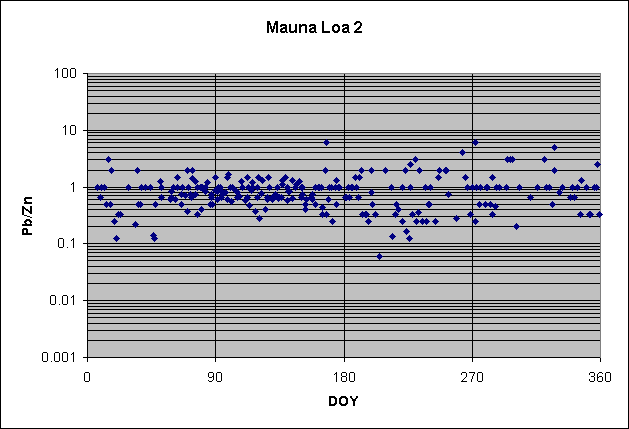
The IMPROVE data for Pb/Zn
As with Ca/Si, the point of examining the Pb/Zn ratio is
to try to determine sources of aerosols, or least to identify different aerosols
over the United States. With Ca/Si, it was to search for sources of the crustal
component. For Pb/Zn, it is for sources of the pollution component. The two
answers may or may not be the same.
Oversimplifying a bit, we can say that the main types of
aerosol revealed by the crustal elements are Pacific aerosol (suspected to be
largely from Asia), local western aerosol, local eastern aerosol, Arctic
aerosol, and Saharan/Atlantic aerosol. The starting question is whether the same
five groups appear for the pollution aerosol. The answer is "not
quite."
The Pacific aerosol, seen both for crustal elements and in
concentrations of Pb and Zn, is also seen for the Pb/Zn ratio. It is
characterized by its appearance in spring and by its Pb/Zn ratio near unity. In
Hawaii, it shows up most clearly in the data from Mauna Loa, as shown below.

Note the well-defined ratio of about 1 in the springtime, the time when
concentrations of both Pb and Zn are also peaking. We can take this as our
reference value for Pacific pollution aerosol, at least during spring.
This same value is seen at many sites in the West during
spring, when the individual concentrations of Pb and Zn also peak. Here are
representative plots, for the four sites of Salmon National Forest, Idaho, Lone
Peak Wilderness, Utah, Brooklyn Lake, Wyoming, and Great Sand Dunes,
Colorado>
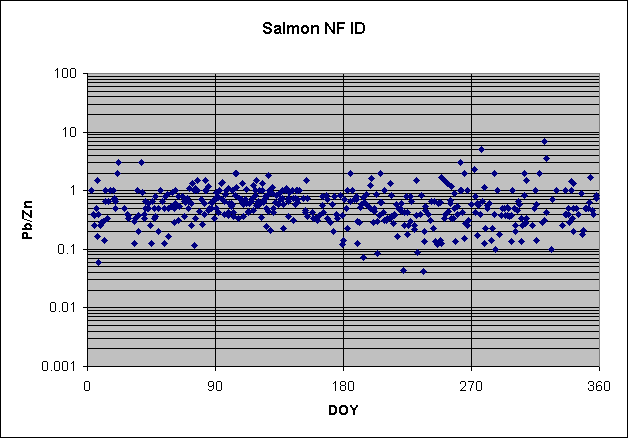

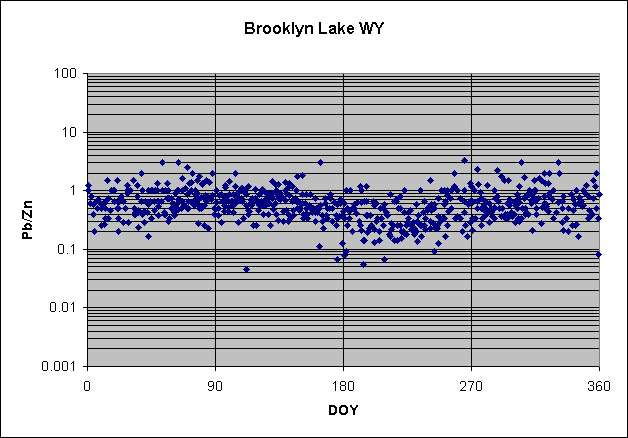
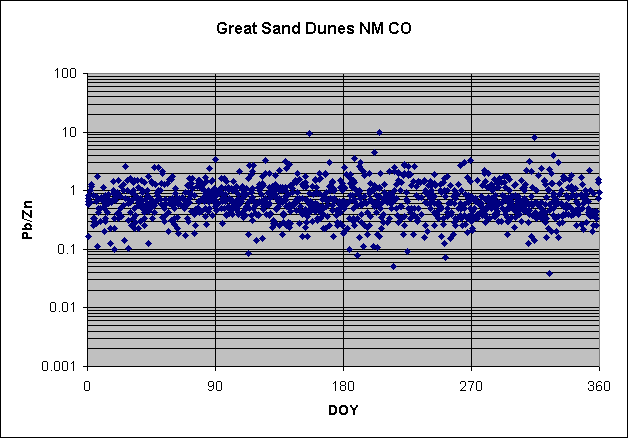
Note the clustering of values about 1 at each site during spring.
Of course, a ratio has to be different from ratios of other
aerosols if it is to be used to discriminate them. That is the case for Pb/Zn,
both at places other than the West and in seasons other than spring. For
example, three of the four sites shown above have Pb/Zn ratios markedly lower in
summer than in spring. If either the Pacific ratios are the same in summer or
the concentrations at the western sites are too high to have been from Pacific
aerosol (both of which seem to be the case), the changed ratios mean changed
sources.
Spring Pb/Zn ratios near the West Coast can also be seen to
systematically peak in Northern California and southern Oregon. Starting at
Columbia River Gorge, Washington, values are low (0.3 to 0.5 or so). The climb
to a maximum of 1 at Three Sisters Wilderness in central Oregon, then to a
maximum of 2 in Crater Lake in southern Oregon. They drop by about 25% at Lassen
Volcanic NP in Northern California and retain that value through Bliss SP and
Yosemite NP. By Sequoia NP they have declined to less than 1, and fall still
farther by Dome Lands Wilderness.
Ratios in the east are also systematically lower than the
Pacific values, and do not vary much with season. Here are representative plots,
for the four sites of Mammoth Cave NP, Kentucky, Sipsy Wilderness, Alabama,
Okefenokee NWR, Georgia, and Brigantine NWF, New Jersey. Their Pb/Zn ratios are
typically 0.2 to 0.6.
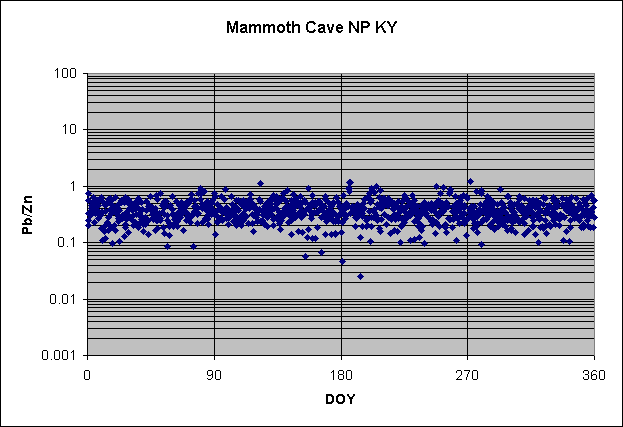
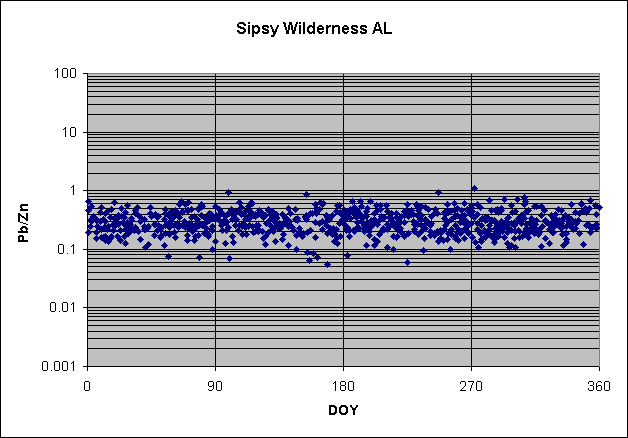
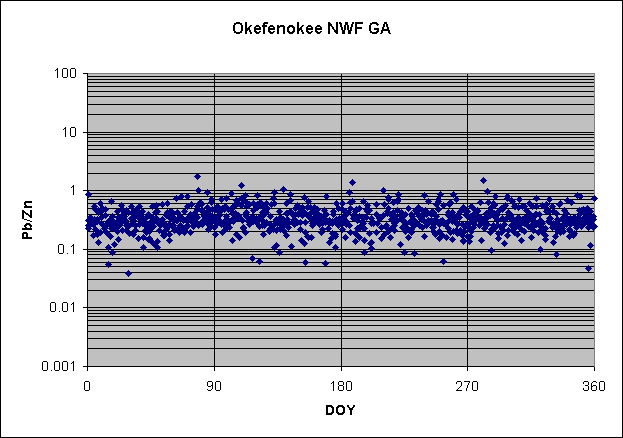
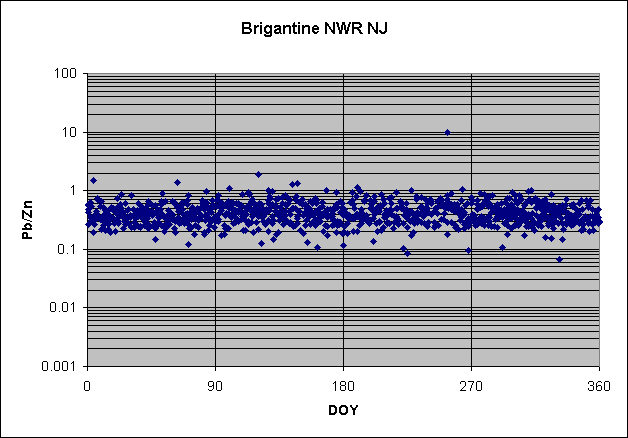
The summer intrusion of Atlantic air into the Southeast do
not seem to change the Pb/Zn ratios there, although the concentrations of the
two elements drop by factors of two to three. Thus the Pb/Zn ratio does not
offer a tracer of Atlantic air.
The ratios along the northern border are generally similar to
those farther south, although a couple of the sites show slightly elevated
values in summer. Generally speaking, though, the higher concentrations of
northern winter are not accompanied by a distinct Pb/Zn ratio, other than its
differing from the spring peak in the West. A typical plot is that for Voyageurs
NP, Minnesota, which shows a spring peak that lasts into summer.
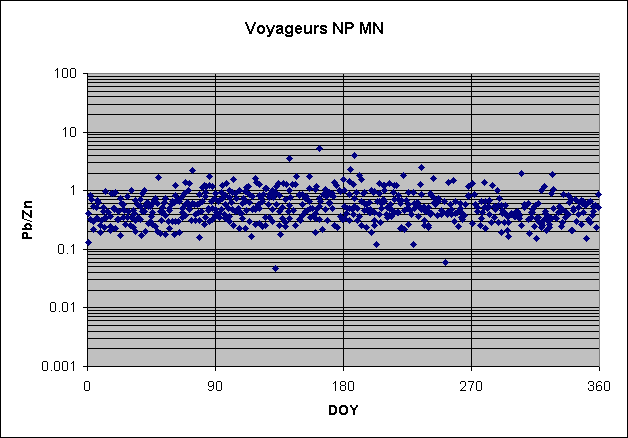
In summary, the Pb/Zn ratios display only two characteristic values, near 1 for Pacific aerosol impinging on the West and 0.2 to 0.6 for the other seasons and places. This restricts this ratio from doing much else than differentiating transported Pacific aerosol from native U.S. aerosol. It does this quite well, however, and shows that except for a site or two in Montana, the signal of the Pacific aerosol gets lost as soon as it crosses the Rockies.